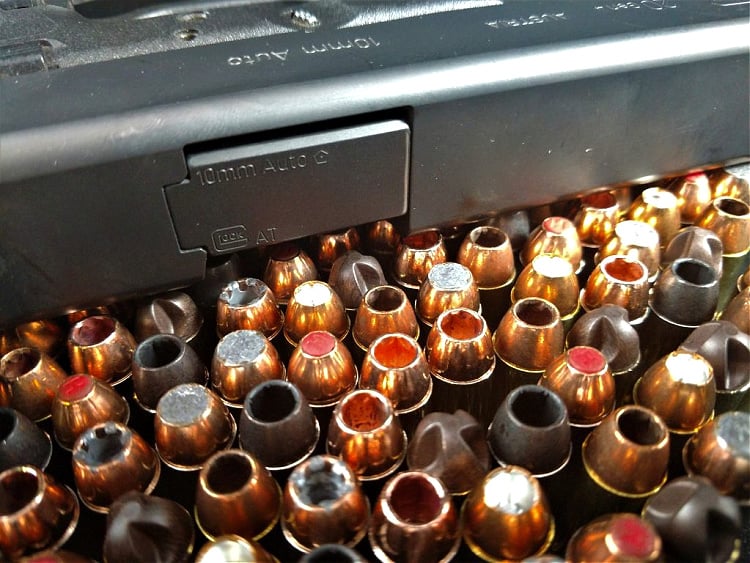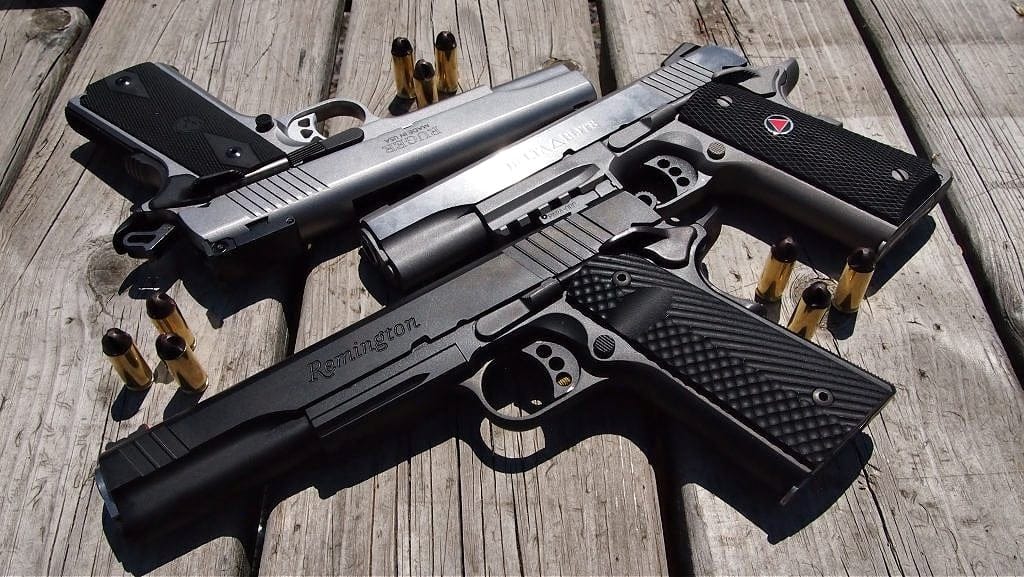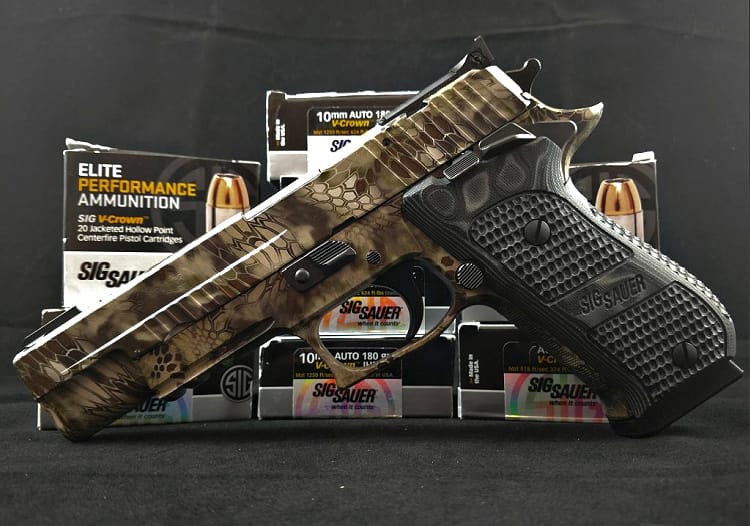In the world of caliber debates, you usually run into fights over .380 ACP versus 9mm or whether 45 ACP is a viable self-defense option in this day and age. However, there is a cartridge that’s been getting more attention, and deservedly so — the 10 mm Auto. As cartridges go, this is one of the younger ones — it isn’t even 50 years old yet — but it’s gone through quite a bit in its brief lifetime. Whether you’re a fan of 10 mm or a skeptic unsure of its applications, you’ve come to the right place. Read on to learn more about the background, history, and usefulness of 10mm Auto.

10mm Auto — Background
We owe the creation of the 10mm Auto to none other than the late Colonel Jeff Cooper. If you’re unfamiliar with Cooper, no worries — you’re about to learn all about him. Cooper founded what is now Gunsite Academy in 1976 west of Paulden, Arizona. At that time, the academy was known as the American Pistol Institute (API) and was considered unique because firearms academies were not yet standard practice. The academy was founded based on Cooper’s development of what is known as the Modern Technique of the Pistol, which remains relevant for shooters today.
The 10mm Auto came into being because Cooper wanted a larger bore defensive caliber. He especially wanted a cartridge capable of producing a greater velocity with a 200-grain bullet. His gun of choice had long been the 1911 chambered in .45 ACP, but he wasn’t happy with its ballistics (understandably). Having a defensive pistol that could reach out and touch its target without dramatic drop was another of his goals.
It was 1982 when Cooper and a few friends, including former Guns and Ammo editor Whit Collins and pistolsmith Irving Stone, began working out the details of the as-yet nonexistent cartridge. The general concept might seem simple in hindsight but likely took some thought at the time: the men used a 30 Remington case cut down to 0.992-inches and a 40-caliber bullet. Once they had the basics figured out, Cooper went looking for a manufacturer to fine-tune and mass-produce the round, and that’s how Norma got involved.
In 1982, Norma was known as FFV Norma AB (today they’re Norma Precision AB). Their involvement in creating the 10mm Auto occurred because Dornaus & Dixon Enterprises requested their help. The exact sequence of events is a little muddy thanks to various opinions and thoughts on who truly pioneered the cartridge. According to the 1984 Dornaus & Dixon catalog, it went down like this:
Dornaus & Dixon Enterprises was formed in December 1979 with the combined efforts of two men, Thomas F. Dornaus and Michael W. Dixon, who had decided to build what they hoped would be the heir to the Colt .45 Auto. In January 1980, they went seeking advice from the most knowledgeable sources available. This effort naturally led to Jeff Cooper. Upon seeking his advice, it was discovered that Jeff Cooper, likewise, was working on such an arm. It was decided that Dornaus & Dixon and Jeff Cooper would join forces, with Jeff Cooper providing conceptual design criteria, as well as technical advice based on his vast practical experience, and Dornaus & Dixon providing the engineering, development, manufacturing, and marketing expertise. To retain his professional objectiveness, Jeff Cooper is not an employee of Dornaus & Dixon Enterprises, nor does he have any authority in the manufacturing of the Bren Ten.
On July 15, 1981, Dornaus & Dixon Enterprises, Inc. became a legal entity and was incorporated by the Secretary of State, in the State of California. On November 1, 1982, the manufacturing facility was dedicated in Huntington Beach, California.
The 10mm Auto’s history is a little “chicken or the egg” but we know for a fact Cooper was involved, Dornaus & Dixon had contact with him after he’d already gotten deep into the concept, and Norma became the manufacturer of choice.
What does the Bren Ten have to do with it?
Although the Bren Ten wasn’t the pistol that would eventually drive 10mm Auto to fame, it played a key role. Michael Dixon and Thomas Dornaus of the aforementioned Dornaus & Dixon Enterprises designed the gun in 1983 specifically to be used as the launching point for what they and Cooper hoped would be the hot, new cartridge. So, whatever happened to the Bren Ten?

The pistol had been loosely based on the CZ-75 and had a stainless steel frame and carbon steel slide. At its most basic summary, the Bren Ten is/was a short-recoil operated, locked-breech semi-automatic double-action/single-action pistol chambered in 10mm Auto. Ever optimistic, Dornaus & Dixon designed the guns with 45 ACP conversion kits for the full-size models and included admittedly cool features like the magazine’s base plates being usable as a wrench to remove the barrel bushing of the gun. However, after the pistol was designed and released in 1983, it ran into some issues.
1500 Bren Tens were made, and they were prone to failure. Problems included fractured slides, which, of course, led to failures and missing or inoperable magazines. And if your magazine was missing when your gun arrived, you’d be hard-pressed to get your hands on one. On the BrenTen.com website, a Bren Ten collector named Bruce shared the following information on the gun’s slide failures:
Based on what I’ve learned over the years, the slide issues stem from a number of problems. All investment castings for major Bren Ten components came from the same Texas foundry. All Bren Ten slides, regardless of model, are made from the same casting, and all, therefore, share their weaknesses. The castings, especially those for the slides, tended to be porous. Dornaus & Dixon’s budgetary constraints precluded the luxury of in-house testing for hidden defects. Add to this the usual growing pains and quality control problems, and “presto,” all the ingredients for major problems are in place!
Imagine that there is an area containing dozens of minute voids between the bottom of the ejection port and the bottom of the slide. These are below the surface and unseen. Every time the weapon is fired, the stress in this area causes microscopic fissures emanating from one void to travel in all directions, including toward other voids. As the firing continues, the dots are connected, this area is progressively weakened to the point that a crack suddenly forms and the part fails in that area. This process is what appears to be the underlying condition resulting in the majority of the slide failures.
There have been a lot of empty promises from firearms manufacturers in the gun industry looking to further their popularity by resurrecting the Bren Ten. In 1986, entrepreneur Richard Voit of what would become Peregrine Industries bought the rights to the Bren Ten after Dornaus & Dixon went through bankruptcy. However, Peregrine Industries themselves fell into financial difficulties. The next noteworthy Bren Ten attempt took place in 2008, when Vltor Weapon Systems decided they’d launch their own version of the infamous 10mm. That project stagnated for various reasons.
This brings us to the most recent Bren Ten recreation attempt, made by Elite Warrior Armament. In 2017 they not only announced their plans for the coming pistol but began taking deposits for the gun that had not yet been produced. At the time of this writing, the gun still has not been made. It would seem the Bren Ten is something of a doomed design.
On to the Miami Vice portion of 10 mm Auto history.

What Does Miami Vice have to Do With 10mm?
Right about the time the 10mm was officially created and the Bren Ten was the latest, hottest gun to have, Miami Vice was the television show of the moment. Detective “Sonny” Crocket, the television character played by star Don Johnson, carried a Bren Ten during the first and second seasons of Miami Vice (he didn’t have the gun yet in the show’s pilot episode).
In an interesting bit of gun industry lore, this was also a part of how the popular holster manufacturer Galco rose to early fame. The holster Don Johnson’s character used to carry his Bren Ten was then known as the Jackass Rig, because Galco was first founded as The Famous Jackass Leather Company. After the rig became known for Miami Vice, Galco changed its name to the Miami Classic. And that is the story of how the 10mm Auto and Galco carved their first public niche.
What Really Made 10 mm Popular?
Two separate events saved the 10mm from becoming obsolete. The first was the design and manufacture of the Colt Delta Elite in 1987. The gun was chambered in 10mm and brought the cartridge some much-needed attention, but not enough.

On April 11, 1986, what would become known as the 1986 FBI Miami Shootout took place. The incident involved ten people, eight of whom were FBI agents, and resulted in several deaths. Sadly, the two agents who were murdered by a pair of serial bank robbers were armed with what were truly subpar weapons (as were all the agents). In fact, every agent but one was shot and wounded that day. The agent who managed to halt the firefight was Special Agent Edmundo Mireles. He was badly wounded but still figured out how to work the pump action of a Remington 870 shotgun one-handed, likely saving the agents who were still alive at the time.
In the aftermath of the firefight, the FBI decided that the calibers the agent’s guns were chambered in were a significant factor in the loss of life. This began a great deal of ballistic testing and research that would affect the entire firearms industry to this day. The FBI ended up deciding the 10mm was their best bet, but over time discovered their agents had trouble controlling the firearms, resulting in declining accuracy. There was also the issue of the barrels burning out faster than barrels in smaller, lower-powered calibers. Following this gun history trail would take us to the 40 Smith and Wesson, but that’s a story for another day.
Is 10mm There Yet?
Yes, but no. 10mm has seen a jump in popularity largely due to use by handgun hunters who recognize the round’s usefulness on all manner of game and predators. Thanks to the cartridge’s use by those hunters, manufacturers responded by designing long-slide handguns suited for making longer shots while hunting. Every so often a manufacturer such as Nighthawk comes out with inarguably beautiful guns chambered in 10mm which lends to its climb in popularity.

Today 10mm is still seen as being the purview of handgun hunters, but there are those whose everyday carry guns are chambered in it. Marty Hayes, the founder of Firearms Academy of Seattle, carries a Nighthawk 1911 chambered in 10mm for self-defense purposes. He isn’t the only one, just one of the better-known shooters doing it.
Can it be Used for Self-Defense?
This is a question with two answers because although 10mm can certainly be used for self-defense, it does tend to over-penetrate. The characteristic that makes it fantastic for hunting also makes it questionable when concern for over-penetrating your target and injuring an innocent bystander is at an all-time high. If the correct ammunition is used, the chances of a bullet causing trouble go down significantly. After all, any round can over-penetrate its target and move on to strike something or someone else. It’s all about ammunition selection, shot placement, and knowing not only your target but what is beyond it.

What are some good 10mm Guns?
Some of the most popular guns chambered in 10mm are Glocks. Glock makes the G20, which is a full-sized 10mm pistol with a 15-round capacity, and the G29, their sub-compact model with a 10-round capacity. Both are 10mm and offer various benefits — the G20 is solid for handgun hunting and the G29 can be used as a carry gun. The two models are accurate and reasonably comfortable as well, assuming your hand size works well with a double-stack design.

As mentioned before, the Colt Delta Elite is a well-known 10mm pistol in the 1911 pistol platform. The Delta Elite is a heavier steel-frame pistol, which nicely offsets the felt recoil of 10mm, and it’s not just accurate but precise. It has an 8-round capacity. Another version of that gun is the Colt Delta Elite Rail which is literally what it sounds like: a Delta Elite with an added rail ahead of the trigger guard.
If you’re looking for a revolver in 10mm, Smith and Wesson makes one. Their model 610 is a six-shot revolver with a 6.5-inch barrel, front blade sight, and overall empty weight of 50.1 ounces. As seems to be the trend in 10mm handguns, the 610 is accurate and its stainless steel frame and barrel add helpful weight.

Finally, there is the Sig P220, an external hammer-fired, semi-automatic 10mm pistol with an 8-round capacity. Sig Sauer has made a few versions of this gun, including the Legion, Elite, and Hunter. Although the Legion version has certainly been created with fine-tuned features, all of the P220s are nice handguns.
There are other 10mm handguns out there, so whatever you’re looking for, it’s probably out there somewhere. Unless you’re looking for a Bren Ten. If that’s what you’re after, you’re probably not going to find it.
10 mm Load Information

SAAMI (Sporting Arms and Ammunition Manufacturer’s Institute) states the maximum pressure of the 10mm Auto is 37,500 psi. C.I.P. (Commission Internationale Permanente pour l’Epreuve des Armes a Feu Portatives) lists their suggestion for maximum pressure a bit lower at 33,000 psi (if you’re wondering, that translates as Permanent International Commission for the Proof of Small Arms).


However, 10 mm Auto was designed to be a higher-pressure round. Some handloaders claim to load tens of thousands higher than the SAAMI standard of 37,500 psi, while others feel comfortable hovering around 44,000 psi. We’re not recommending you go beyond SAAMI specifications. In fact, many if not most modern 10mm-chambered handguns simply aren’t designed to withstand the cartridge’s original intended pressure.
There are manufacturers loading hotter 10mm rounds, such as Buffalo Bore Ammunition. Tim Sundles, the founder of the company, wrote the following on his website regarding the release of their Dangerous Game 10mm load:
We are releasing our new 10MM Auto Dangerous Game load. It features the new Lehigh Defense 190 gr., flat nose, Mono-Metal bullet. This bullet was designed by me, with the help of Lehigh Defense. There are a number of dynamics I do not like (they are not simple) in developing the 10MM DG cartridge, with its very limited case capacity, versus seating a very long-for-weight, Mono-Metal bullet into that small casing, while keeping pressures down, but velocities up. In spite of the difficulties with these internal ballistics’ dynamics, we were able to design a very capable 10MM load that utilizes a bullet designed to never expand or deform on mammals and thus penetrate deeply in a straight line as it encounters big bones, muscle, and liquids, etc. The testing and design work took months as I wanted this load to be nothing but right, right, right!
Buffalo Bore’s 10mm Auto Dangerous Game chart:

Another company making hotter, heavier 10mm rounds is Double Tap Ammunition. Founder Mike McNett has done a fair amount of work on the 10 mm, among others, and the proof is in their quality ammunition. Double Tap’s 10mm 230-grain Hardcast Solid WFNGC (Wide Flat Nose Gas Check) round has a muzzle velocity of 1120 feet per second and muzzle energy of 641 foot-pounds fired from a Glock 20. Their lighter-weight load, 10mm 150 grain Controlled Expansion JHP (Jacketed Hollow Point) produces a muzzle velocity of 1475 feet per second and muzzle energy of 725 foot-pounds, also through a Glock 20.
Should You Get a 10mm pistol?

Short answer: highly recommended.
Of course, it does depend on your need and use for such a cartridge. If your only possible use is for carry, you might find you prefer a gun chambered in 9x19mm. Conversely, if you’re a handgun hunter, a 9x19mm does you no good. 10 mm has many uses and it can be an enjoyable round to shoot in the right gun, with a good skillset. It’s all about using the correct cartridge for your particular needs.

10mm Auto Specifications
Brainstormed by: Col. Jeff Cooper
Designed by: FFV Norma AB, now known as Norma Precision/Norma Ammunition
Entered production: 1983
First gun chambered in it: Bren Ten
Parent case: 30 Remington
Variant: 40 Smith and Wesson, 9x25mm Dillon, 9x25mm Super Auto G, 357 SIG
Case type: Rimless, straight-walled
Bullet diameter: 10.17mm (0.400-inch)
Neck diameter: 10.74mm (0.423-inch)
Base diameter: 10.8mm (0.425-inch)
Rim diameter: 10.8mm (0.425-inch)
Rim thickness: 1.40mm (0.055-inch)
Case length: 25.20mm (0.992-inch)
Overall length: 32.00mm (1.260-inch)
Primer: Large Pistol
Maximum pressure (SAAMI): 37,500 psi
Maximum pressure (C.I.P.): 33,000 psi


